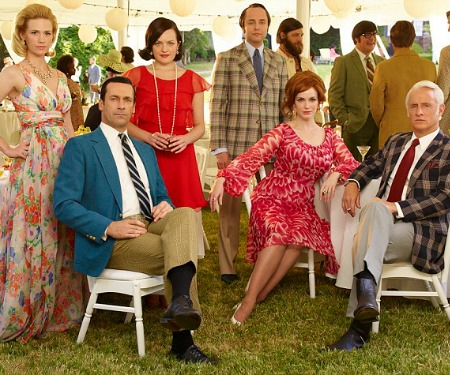‘Mad Men’ Kicks Off Goodbye Tour

New York – With two weeks to go until AMC’s Mad Men kicks off its last batch of episodes, the goodbye tour is full swing.
Mad Men creator Matthew Weiner and the show’s stars Jon Hamm, John Slattery, January Jones and Christina Hendricks held court in front of a sold out and raucous crowd at Lincoln Center’s Alice Tully Hall on Saturday night. The event was one of the many that will be held throughout New York over the next few months to commemorate the end of the show.
“It’s really weird to not be thinking about it all the time,” Weiner told the crowd of the production being over. He mentioned he still couldn’t help but come up with potential storylines.
Mad Men returns April 5 for the final seven episodes of its seven-season run. As AMC did with Breaking Bad, the network split the final season of Mad Men in two parts, airing a year apart. “It was different, splitting it up like this,” Weiner told the crowd. He explained the final seven episodes focus almost exclusively on the core characters. “There is not a lot of going off the road for a certain kind of story. We’re right in it the whole time.”
Weiner and the cast spent the night sharing their favorite clips from the show’s first six and a half seasons, which included memorable scenes such as Don’s reveal of his true past to Betty, Roger hitting on Betty in Don’s kitchen and the first time viewers were introduced into the relationship between Roger and Joan.
Below are a few highlights from event:
Some of the show’s best scenes were done to save money.
Early in Mad Men’s run, when AMC had not yet established itself a place for premium original content, the budget that Weiner had was miniscule. “There is not a lot of rehearsal,” he said, noting they usually only had enough in their budget to do two takes for each scene. “[The cast] prepare a lot at home.”
When they played the scene from the first season, where it is first revealed that Roger and Joan had a romantic relationship, Weiner said the five-minute hotel scene was done primarily to save money. “We have one set, we have two actors. How interesting can we make these five minutes of the show?”
The widely lauded season four episode “The Suitcase,” which focused almost exclusively on Don and Peggy was done primarily to keep costs down. “This was our saving money episode,” he said, explaining that the episode was added in as filler, so the budget was relatively small.
The episode where Roger (John Slattery) performed in “Blackface” was uncomfortable for everybody.
Though this was not one of the clips that was shown, the cast spoke at length about the scene in the season three episode “My Old Kentucky Home” where Roger does a performance of “My Old Kentucky Home” in blackface.
Hamm, who joked that the whole thing was his idea, recalled Slattery telling him “this is the last day of my career.” While the audience got a nice laugh, Weiner explained the scene was anything but a fun affair.
“It was not pleasurable for anyone,” he said, likening the experience to having to portray a Nazi solider. Weiner continued that was contention from the writers room about doing that scene. “We had a lot of new writers who said ‘we can’t do this.’”
Among the many reasons for the lofty praise heaped on Mad Men has been its historical accuracy. The episode took place in 1963, at a time when performing in “blackface” was still socially acceptable in some circles. “That episode was so much about white people and what they are like when they’re alone.”
While the whole experience was uncomfortable, Weiner defended using it because he said they made it obvious the characters were against it. “It was so clear that we were criticizing it,” he said. “But we had to live through doing it to criticize it.”
Weiner Knew He Asked a Lot From Viewers.
“We did not have to spin the storytelling out of control to keep the audience interested,” said Weiner, who praised the show’s viewers for being able to keep track of the many storylines, some of which would be shuttered only to reappear seasons later.
“You’re expecting the audience to keep track,” he said, noting multiple times his hatred of exposition. “You just can’t come back next season and tell them what happened.”
Mad Men bucked a lot of storytelling conventions, with one of them being the consistent use of time jumps. Many episodes would jump a month or more ahead and each season began in a different year. Weiner said he loved making the audience figure out what year the show was currently in without some big historical event to guide them.
“I enjoy being mystified, I enjoy being confused for a moment,” he said. “It’s so much more satisfying when you’re illuminated.”
Broadcasting & Cable Newsletter
The smarter way to stay on top of broadcasting and cable industry. Sign up below



